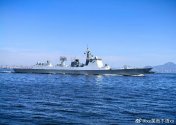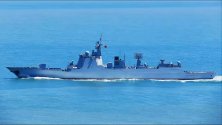055 is great against warship vs warship. but
In the modern warfare, they need a warship that can deal with hundreds of drones and UUV at once. Perhaps a warship with multiple laser system and CIWS.
A single warship that can destroy swarm satellite, water drones and air drones..
Under what circumstances do you envision a blue water AAD Destroyer having to deal with "hundreds of drones and UUV at once"? And how big are these drones to begin with?
Cos the issues that pop immediately ...
Size -
If these drones are big then who in the world has the capability to sortie that many defacto cruise missiles at a fleet? And I use fleet because what are the odds that you have an 055 all by itself?
If these drones are small, then range is short, then how is that small drone gonna have the range to get to a blue water platform like the 055?
Speed -
Typical characteristic of a drone is they are slow. We're talking 100+kmph being typical. Contrast with traditional sub-sonic AShM threat that vector in at almost an order of magnitude faster.
Speed = engagement time. 10 times slower means each defending platform can engage up to 10 times that number of incoming drones vs subsonic AShM (hence the pucker factor behind high supersonic/hypersonics AShM)
You combine the above 2 (Size + Speed) ..
- If your drone is big+fast=Long Range, you have effectively a cruise missile. Again, who in the world has that magazine depth and capability to alpha strike 500+ cruise missiles at a CSG/SAG/ESG? Answer, probably only PLAN actually (and only within 1IC).
- If your drone is big+slow=Long Range, you have even more time for the target fleet to literally pick and choose how to defend against you. Refer to the recent Iranian strike against Israel - every single drone was picked off in their multi-hour transit to the target.
- If your drone is small+anything=Short Range, you can't get at a 055 that is OTH. So where are you launching from? Far easier for the 055 to sink your launch platform than deal with your "hundreds of drone".
You could of-course redesign a harpoon analog that instead of a unitary warhead, carries 10 switchblade like drones up to 40km from target fleet and then dispense them. But again, the 055 can simply engage your carrier AShM at 40+km range and be done with it using 2 AAMs.
Not to mention that a switchblade analog is still a slow drone which will take about 20 minutes to cover 40km. An eternity for DP Guns and CIWS ... You could even literally scramble helos with door guns to turkey shoot them.
Guidance -
Autonomous drones or FPV/Man-in-the-Loop drones?
If it's FPV like a lot of current drone strikes that is creating the buzz you are on, how are you going to relay guidance all the way to where the blue water 055 is? In a hostile EW environment?
If self-guided/autonomous, you've effectively made your drones into mini-AShMs = very costly and doubled/tripled/[insert ballpark figure here] the cost of your baseline AShM cruise missile. All for nothing if this drone carrier missile gets taken out before it can deploy it's load.
Lastly ... what effect on target do you hope to have with mini warheads?
I fear you are confusing the effect of drones on
land warfare - large area, spread out targets, limited GBAD assets to cover everything in that area, plenty of cover for drone operators to get close enough.
fleet defense - I am the target, optimal placement of AD assets literally at the target, very little cover for drone operators to get close enough.
Last edited:




